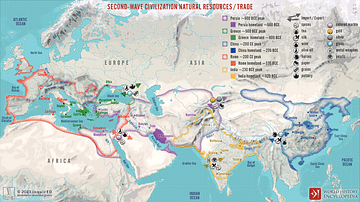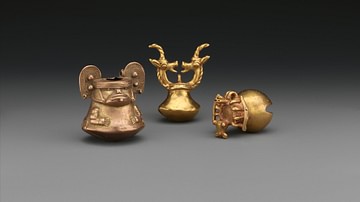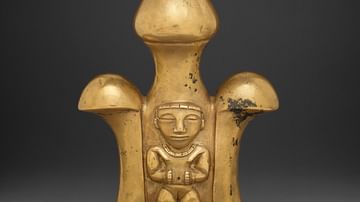Search
Search Results

Image
Second-Wave Civilization Natural Resources and Trade
A map illustrating the rise and spread of the Second Wave Civilizations between c. 500 BCE and 200 CE (including the Persians, the Greeks, the Romans, the Chinese, and India) with the flows of trade in major goods and resources.

Image
Tumbaga Bells of the Tairona Civilization
Bells made from an alloy of gold and copper (tumbaga) by the Tairona people of Colombia. c. 1500 A.D.

Definition
Greek Dark Age
The Greek Dark Age (c. 1200 to c. 800 BCE, overlapping with the Iron Age, c. 1200-550 BCE) is the modern-day term for the period in Greek history following the Bronze Age Collapse when the Mycenaean Civilization fell and the Linear B writing...

Image
Lime Container (Poporo), Quimbaya Civilization
A Poporo is a container used for storing lime that could be procured by crushing seashells and would later be eaten with coca leaves- a tradition in Pre-Columbian South America. This Poporo, made out of gold with a nude female figure carved...

Video
The Maya Calendar, Culture and History: an Introduction to a Mesoamerican Civilization
The Maya are a people indigenous to Mexico and Central America who have continuously inhabited the modern regions of Yucatan, Quintana Roo, Campeche, Tabasco, and Chiapas in Mexico and southward through Guatemala, Belize, El Salvador and...

Video
The End of Civilization in the Bronze Age: Crash Course World History 211
In which John Green teaches you about the Bronze Age civilization in what we today call the Middle East, and how the vast, interconnected civilization that encompassed Egypt, The Levant, and Mesopotamia came to an end. What's that you say...

Definition
Ancient India
India is a country in South Asia whose name comes from the Indus River. The name 'Bharata' is used as a designation for the country in their constitution referencing the ancient mythological emperor, Bharata, whose story is told, in part...

Definition
Sumer
Sumer was the southernmost region of ancient Mesopotamia (modern-day Iraq and Kuwait) which is generally considered the cradle of civilization. The name comes from Akkadian, the language of the north of Mesopotamia, and means “land of the...

Video
Indus Valley Civilization
An introduction to the civilization contemporaneous with ancient Egypt and Mesopotamia that inhabited the region around the Indus River in modern day Pakistan and northwestern India.

Video
Cradles of Civilization - From Babylon to China
Dr. Neiman describes the connection between Sumer, Babylon and the development of Chinese civilization.